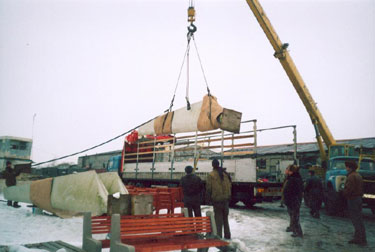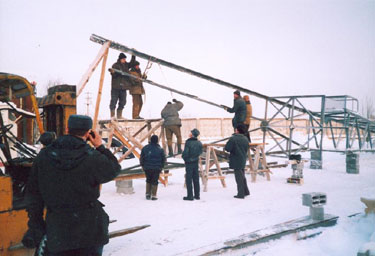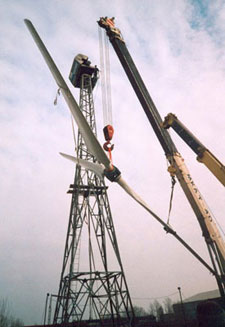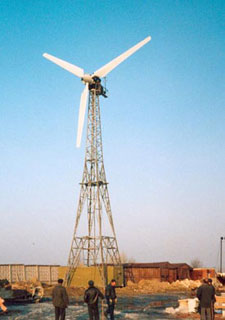Tiempo Climate Cyberlibrary
New Life for Used Wind Turbines
- Tiempo archive
- Complete issues
- Selected articles
- Cartoons
- Climate treaty
- Latest news
- Secretariat
- National reports
- IPCC
About the Cyberlibrary
The Tiempo Climate Cyberlibrary was developed by Mick Kelly and Sarah Granich on behalf of the Stockholm Environment Institute and the International Institute for Environment and Development, with sponsorship from the Swedish International Development Cooperation Agency.
While every effort is made to ensure that information on this site, and on other sites that are referenced here, is accurate, no liability for loss or damage resulting from use of this information can be accepted.
 |
Svetlana Volchek describes the innovative transfer of used wind turbines from Denmark to Russia to kickstart an indigenous wind energy industry. |
|
The author is a former PhD student at the St. Petersburg Technical University. She is presently a student at Aalborg Universit in the Sustainable Energy Engineering Master of Science programme. |
|
Over the past five years, the Danish government has supported increases in the size of wind turbines in the country. Smaller wind turbines were taken down even though these turbines were operating successfully.
As a result, a number of second-hand wind turbines have become available in Denmark that can work well for another ten to twelve years. Refurbishing these turbines and installing them in Russia is a more cost-effective method of introducing wind turbine technology than the purchase of new wind turbines.
The St. Petersburg and Leningrad regions in Russia have high wind speeds and a considerable potential for the implementation of wind energy technology. In 2001, there was a good opportunity for realizing a project to integrate a wind turbine into the energy supply of an industrial company in St. Petersburg. Private financing made it possible to undertake the project, based on one of the used wind turbines from Denmark.
A private company, Krasnoe, and the St. Petersburg State Technical University were the initiators of the project, which included the buying and installation of the used Danish wind turbine - the Wind Matic 75 kW.
|
|
Arrival of Wind Matic in St Petersburg © Svetlana Volchek |
The Danish Folkecenter for Renewable Energy supported the project. It also assisted in selecting, purchasing, and packing the wind turbine, and contributed a new computer for integration into the original control system.
The wind turbine Wind Matic was bought by the company Krasnoe in Denmark after 13 years of operation. This was an experimental project on the basis of which all questions regarding the optimal exploitation of such wind power plants could be resolved.
Krasnoe, who produce different kinds of building materials, decided to install the turbine on their own premises to reduce their energy expenses. At the same time, their own consumption of the electricity was and still is the only way to make the project feasible, since there is no payment for power fed into the Russian grid.
When we started realization of this project, we expected various problems - they began to appear immediately. This kind of equipment has never been delivered before in Leningrad oblast. Therefore, nobody knew clearly the mechanism of conveyance and customs requirements.
We were taking the first steps on this path as pioneers, and of course we faced risks. For instance, the contract for buying the wind turbine was changed five times in order to meet the requirements of customs.
|
|
Assembling the tower © Svetlana Volchek |
Finally, after overcoming the customs barriers, we got Wind Matic together with new challenges. The workers who were going to install the wind turbine knew only that this machine could produce electricity by using wind. This was all they knew. At this stage of the project, Folkecenter for Renewable Energy was our consultant, and provided training and complete technical know-how for installation, operation, and maintenance.
The transfer of know-how partly took place when we were in Denmark, and continued during the following implementation phase. In this way, we could educate the group of people involved in this project. They did all of the work, starting with building the foundation, then integrating the new computer into the control system, and finishing by putting the Wind Matic into operation.
|
|
Installing the rotor © Svetlana Volchek |
After all of the complications introduced by the lack of on-site experience with the installation of such equipment were overcome, the wind turbine successfully started operation on 26 April 2002. The period from agreement with seller to installation of the wind turbine in St. Petersburg was ten months.
After one year of successful operation, calculations showed that the average energy savings during the summer period were 27 %, while the energy savings during the winter period, when the wind speeds are higher, were around 45%. Economic calculations show that the pay back time for the wind turbine is 4.5 years at the present cost of electricity.
|
|
Ready for operation © Svetlana Volchek |
The project was presented as one of the contribution from Leningrad Oblast at the national energy-savings competition in Moscow in 2003. Both Krasnoe and the St. Petersburg State Technical University received awards.
This first experience helped us to buy the next wind turbine, Vestas V19 90 kW, in Denmark. The wind turbine was installed in 2003 for a private investor, also in the St. Petersburg region. The third wind turbine is already in St. Petersburg, and will be installed in the near future.
Further information
Email: svetlana.volchek@mail.dk.
On the Web
A report on a Danish Folkecenter for Renewable Energy
wind power project in Kaliningrad, Russia, is available
in Acrobat format (1.2Mb download). Visit WindturbineWarehouse.com
for details of refurbished wind turbines, including
recycled Danish turbines.
Acknowledgement
This article is reproduced from Sustainable Energy
News by permission of the author and editors.
Sustainable Energy News is published by the International Network for
Sustainable Energy (INFORSE).
Bright Ideas

General Electric plans to cut solar installation costs by half

Project 90 by 2030 supports South African school children and managers reduce their carbon footprint through its Club programme

Bath & North East Somerset Council in the United Kingdom has installed smart LED carriageway lighting that automatically adjusts to light and traffic levels

The United States National Oceanic and Atmospheric Administration and the American Public Gardens Association are mounting an educational exhibit at Longwood Gardens showing the link between temperature and planting zones

The energy-efficient Crowne Plaza Copenhagen Towers hotel is powered by renewable and sustainable sources, including integrated solar photovoltaics and guest-powered bicycles
El Hierro, one of the Canary Islands, plans to generate 80 per cent of its energy from renewable sources

The green roof on the Remarkables Primary School in New Zealand reduces stormwater runoff, provides insulation and doubles as an outdoor classroom

The Weather Info for All project aims to roll out up to five thousand automatic weather observation stations throughout Africa

SolSource turns its own waste heat into electricity or stores it in thermal fabrics, harnessing the sun's energy for cooking and electricity for low-income families

The Wave House uses vegetation for its architectural and environmental qualities, and especially in terms of thermal insulation

The Mbale compost-processing plant in Uganda produces cheaper fertilizer and reduces greenhouse gas emissions

At Casa Grande, Frito-Lay has reduced energy consumption by nearly a fifth since 2006 by, amongst other things, installing a heat recovery system to preheat cooking oil
Updated: May 15th 2015



